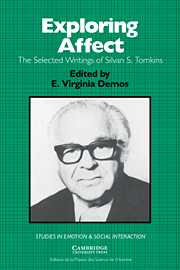Book contents
- Frontmatter
- Contents
- Foreword
- Editor's preface
- List of contributors
- Chronology
- Introduction
- Part I Affect theory
- Introduction
- Selections by Silvan S. Tomkins
- Part II Affect and ideology
- Introduction
- Selections by Silvan S. Tomkins
- Part III The face of affect
- Introduction
- Selections by Silvan S. Tomkins
- What and where are the primary affects? Some evidence for a theory (with Robert McCarter)
- The phantasy behind the face
- The role of facial response in the experience of emotion: A reply to Tourangeau and Ellsworth
- Inverse archaeology: Facial affect and the interfaces of scripts within and between persons
- Part IV Script theory: The differential magnification of affect
- Introduction
- Selections by Silvan S. Tomkins
- Part V Human being theory: A foundation for the study of personality
- Introduction
- Selections by Silvan S. Tomkins
- A complete annotated bibliography of Silvan S. Tomkins's writings
- References
- Author index
- Subject index
- Titles in the series
What and where are the primary affects? Some evidence for a theory (with Robert McCarter)
Published online by Cambridge University Press: 10 November 2010
- Frontmatter
- Contents
- Foreword
- Editor's preface
- List of contributors
- Chronology
- Introduction
- Part I Affect theory
- Introduction
- Selections by Silvan S. Tomkins
- Part II Affect and ideology
- Introduction
- Selections by Silvan S. Tomkins
- Part III The face of affect
- Introduction
- Selections by Silvan S. Tomkins
- What and where are the primary affects? Some evidence for a theory (with Robert McCarter)
- The phantasy behind the face
- The role of facial response in the experience of emotion: A reply to Tourangeau and Ellsworth
- Inverse archaeology: Facial affect and the interfaces of scripts within and between persons
- Part IV Script theory: The differential magnification of affect
- Introduction
- Selections by Silvan S. Tomkins
- Part V Human being theory: A foundation for the study of personality
- Introduction
- Selections by Silvan S. Tomkins
- A complete annotated bibliography of Silvan S. Tomkins's writings
- References
- Author index
- Subject index
- Titles in the series
Summary
Introduction
We have argued (Tomkins, 1962) that affective responses are the primary motives of human beings. We have further assumed that affects are primarily facial behaviors and secondarily outer skeletal and inner visceral behavior. When we become aware of these facial responses (with or without concurrent visceral responses), we are aware of our affects. Later, we learn to generate from memory, images of these same responses which we can become aware of as affect, with or without repetition of facial, skeletal, or visceral responses. On the other hand, we have also assumed that one may respond with facial affective responses without necessarily becoming aware of the feedback from these responses. In short, although the awareness of the feedback of the facial response is the experience of affect, the same experience may later be retrieved from memory, thus bypassing the necessity for a facial response, or the feedback of the facial response may remain unconscious and not be transformed into a conscious message.
Most contemporary investigators have assumed, after the James–Lange theory, that the inner bodily responses are the chief site of the emotions. Important as these undoubtedly are, we regard them as of secondary importance to the expression of emotion through the face. We regard the relationship between the face and the viscera as analogous to that between the fingers, forearm, upper arm, shoulders, and body. The finger does not “express” what is in the forearm, or shoulder, or trunk.
- Type
- Chapter
- Information
- Exploring AffectThe Selected Writings of Silvan S Tomkins, pp. 217 - 262Publisher: Cambridge University PressPrint publication year: 1995
- 1
- Cited by



